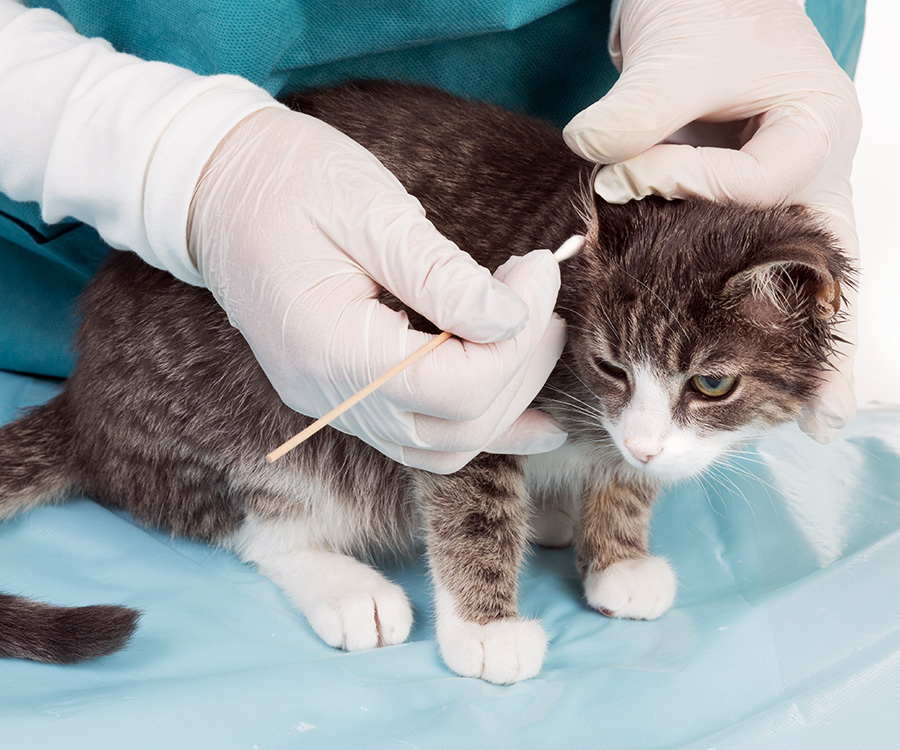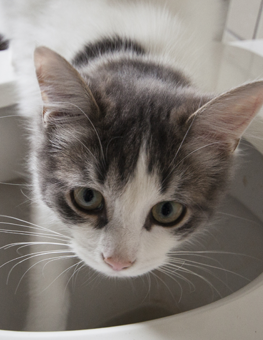Ear Mites and Your Cat
Have you noticed your cat scratching his ears more often than usual? Itchy ears can be a symptom of many different things, including ear infections, allergies, or even polyps. However, ear mites tend to be one of the most common causes of itchy ears when it comes to cats.


If you notice your cat scratching their ears more than usual, contact your veterinarian.
Regardless of the cause, your first step when noticing itchy ears should be to set up an appointment with your veterinarian. Even if you are pretty sure that ear mites are the cause, treating your cat improperly can sometimes cause more harm than good.
Ear mites are barely visible to the naked eye and usually require an otoscope or a microscope to fully detect them. If your cat has been diagnosed with ear mites, or if you suspect he might have them, it’s important to understand what you’re dealing with.
What is an Ear Mite?
The ear mite is a cousin to other types of mites, and also to ticks. Their life cycle is very similar to that of ticks. Their full life cycle from egg to adult lasts about three weeks, which means new egg-laying is constant and overall population growth can increase quickly. These microscopic, white parasites live on the surface of the ear canal, but sometimes can migrate to other parts of the body like the head and neck. Inside an infected ear, thousands of mites are crawling over a black mass of mites, mite eggs, dead mites, ear wax, dried blood, and other debris.
This condition is extremely itchy for your cat and the constant scratching can sometimes lead to the point of damaging the ear flap, the skin surrounding the ear, and even the inside of the ear. Occasionally, your cat may get a bacterial infection on top of his ear mite infection. They don’t just infect cats – dogs and most mammals are all susceptible to getting them.
What are Symptoms of Ear Mites in Cats?
Symptoms of an ear mite infection may include:
- A black, waxy discharge, or crust on the outer ear canal that resembles coffee grinds
- Light bleeding
- Excessive ear scratching
- Frequent head shaking
- Ears are sensitive to the touch
- Head tilt to one side
- Difficulty hearing
How are Ear Mites Transmitted?
Ear mites can also be found on the outside of the body, around the neck, rump and tail and are easily transmitted from animal to animal. Kittens can become infected early in life from an infected mother when the kitten’s ears open at only 10 days of age. Ear mites are highly contagious and can also be passed from an infected pet to other adult pets. If one of your pets shows evidence of ear mites, it’s best practice to treat all the other dogs and cats in the house, too, just to be on the safe side. Just a few wayward eggs can easily cause a re-infestation. Don’t worry, though -- humans cannot be infected with ear mites.
Cats may gradually build up resistance to ear mite infections as they age. Young cats, outdoor cats, and cats acquired from animal shelters should be checked more often than others. Cats that are often sick or have poor nutrition are also more vulnerable.
How are Ear Mites Treated in Cats?


Prompt & proper ear mite treatment can ensure that all of the mite eggs are eliminated.
Once you have identified that your cat has ear mites, treatment requires a few simple steps. It is important to follow the treatment protocol precisely and to see the process through to the end. This will ensure that all of the mite eggs are eliminated and prevent re-infestation.
- Step 1: Clean the ear. Use an ear cleaner designed for cats, never water! Ear cleaner is designed to dry out completely, whereas water can stay in the ear and cause an ear infection. Be sure to follow the directions on the ear cleaner precisely.
- Step 2: Medicate. Do not use any home remedies to try and eliminate the infection. This could cause harm to your cat’s ears. Ear mite medication is relatively inexpensive, effective, and available over-the counter at most pet stores. Hartz® UltraGuard® Ear Mite Treatment for cats contains an insecticide that kills ear mites on contact. It can be applied daily for 7 to 10 days and repeated in two weeks if necessary. Be sure to follow the package instructions carefully. Do not use on kittens less than 12 weeks old.
- Step 3: Clean the ear again. This will remove any leftover eggs or resilient mites. Keep in mind that it only takes a few remaining mites to trigger a re-infestation.
Ear mites are very common in felines, but are easy to misdiagnose to the untrained eye. If over-the-counter treatment is not working, your cat may be suffering from another problem altogether or require a stronger, prescription-strength medication. When in doubt, always consult your veterinarian.
Beyond the obvious physical discomfort to your pet, untreated ear mite infestations can cause ear inflammation and bacterial or fungal infections. Severe cases can lead to hearing loss or ear damage from scratching, so prompt treatment is very important.














